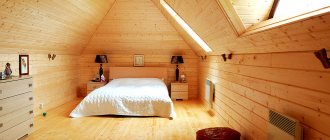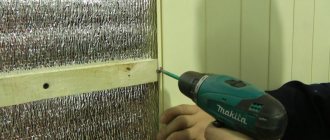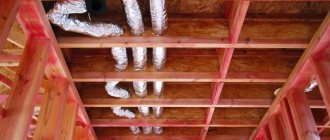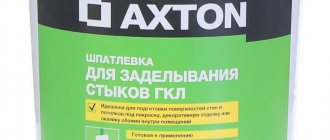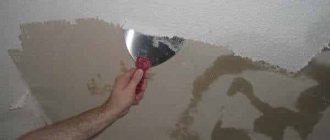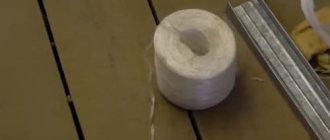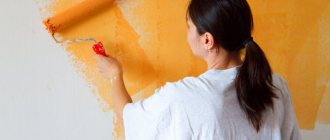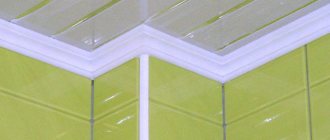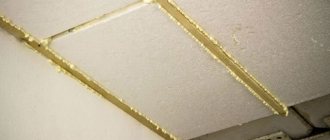A ceiling covered with wooden lining is found both in a private house and in a modern apartment. This environmentally friendly, beautiful material requires a topcoat, since without it the surface will last no more than 10 years. Painting a lining ceiling will allow you to preserve all the properties of the material for a long time, extend the service life of the coating and improve the decorative and aesthetic qualities of the surface. The choice of wood preservatives and finishing compounds is extensive. We will tell you how to paint a lining ceiling.
How to paint the ceiling in a wooden house
The answer to this question depends on the aesthetic preferences of the home owners, but no less on the overall interior of the room. If the house is decorated in a chalet, country or Provence style, or there are many other wooden elements, then a wooden ceiling in the interior will look harmonious and natural. In this case, to cover the ceiling, it is best to use products that preserve the natural texture of the wood:
- antiseptic impregnations;
- decorative lazuli
- varnishes
- stains
If the style of the house does not involve preserving the natural structure of the wood, then there is only one option left - to paint the ceiling with covering paint.
Glazing and coating antiseptics
The products create a protective barrier against unfavorable biological factors (rot, fungus, microorganisms). They are well absorbed and penetrate deeply into the wood structure. Glazing compounds cover the surface with a transparent layer without covering the wood grain. Coating antiseptics give the wood the desired shade while maintaining its texture.
Colorless and tinted decorative glazes
They perform a protective function, block the development of pathogenic processes, increase wear resistance and extend the service life of the coating. Azure allows you to create a matte or glossy surface, change the tone of the wood, and give the wood a silver metallic effect. Lazuries are produced on the basis of water, natural oils and solvents.
It is worth highlighting oil glazes, which have excellent performance and aesthetic characteristics. The best quality indicators are demonstrated by the glazes of the German manufacturer OSMO, which can give even a cheap material a respectable look.
Transparent and colored varnishes
They create a transparent or slightly tinted film on the surface, through which the natural texture of the wood is clearly visible. Water-based acrylic varnishes are excellent for clapboard ceilings. They are safe, have water-repellent properties, and protect the surface from dirt and dust. You can use polyurethane and epoxy varnishes, which form a strong, durable and beautiful coating. A good solution is alkyd varnishes, which are very stable and wear-resistant, creating a lacquered coating with a shimmering effect.
Stains
Stain is a coloring liquid that emphasizes the structure of wood and gives it the shade of a certain type of wood. After treatment with this product, even ordinary wood takes on the appearance of an expensive wood species. Due to this property, stain is often used when painting plywood ceilings. Light-colored stains look very impressive on the ceiling. Staining performs a purely decorative function; to protect the wood and give it water-repellent properties, it is necessary to apply a transparent varnish or drying oil over the stain.
Paints
Covering paints create a durable and durable color coating on the surface that completely covers the natural texture of the wood. For the ceiling, you can use only safe dyes that do not emit odor and do not contain toxic substances. The packaging of the paint should indicate that the product is intended for interior decoration.
The range of paints is very wide. Acrylic dyes are excellent for painting the ceiling, forming an elastic, waterproof coating. A good option is acrylate paints, which retain their rich and bright color for a long time. You can also use silicate, silicone and polyurethane dyes.
You can learn more about the properties of paints intended for interior work in the article “What materials are used to paint the interior walls of a wooden house.” All these dyes can also be used to paint the ceiling.
Selection of coloring composition
In addition to the desired aesthetic effect, it is important to consider the location of the ceiling panel: indoors or semi-open, heated or not, humidity levels.
Let's consider the main groups of products for painting and processing wooden lining:
- Protective compounds . Fire retardants are used to combat fire. Popular brands: “Senezh Ognebio”, “Neobmid”, “Pirilax”. Antiseptics with bactericidal properties are used to combat fungi. Samples for external and internal work are presented. The former protect against ultraviolet radiation and prevent the wood from acquiring a gray appearance. The most popular: “Pinotex”, “Tikkurila”, “Belinka”.
- Tonics or stains . They give wood elements a tint without creating a film; the wood “breathes.” Varied in degree of pigmentation. It is more convenient to use a slightly pigmented option, applying several layers. This makes it easier to control the tone. Popular samples: “Zerwood”, “Rosewood”, “Zar”.
- Lucky . The most modern options are water-based, called aqualaks. They protect well from dirt, while the material remains vapor permeable. For outdoor use, they are selected with UV filters that protect against ultraviolet radiation. It is better if there are antibactericidal components that prevent the development of mold. Compositions with such additives are used for ceiling coverings on balconies, attics, bathhouses, kitchens, and unheated cottages. Alkyd-urethane varnish is popular: it dries quickly, is resistant to abrasion, and is applied with a spray gun. Disadvantages include flammability and unpleasant odor. Suitable for indoor and outdoor use. Modern varnishes dry quickly and allow you to create matte, semi-matte and glossy ceiling coatings. Large selection of this paint and varnish with coloring pigment. For example: “Snezhka”, “White House”, “Poly-R”.
- Paints . They form a shiny film that hides the wood pattern; the color changes with the help of a tint. If you choose oil, then you need to take into account the drying time (24 hours). During application and drying, a strong odor will be felt. Ventilation should be provided. An oil-painted ceiling looks good for 4-5 years, then it needs updating. Water-dispersed compositions have proven themselves to be excellent; they contain polymers dissolved in water. They are more expensive, but suitable for use in winter due to the lack of odor. There will be no need for ventilation. Latex water-dispersion paint is not afraid of moisture, external influences, is resistant to household chemicals, but fades quickly. For ceilings in semi-open spaces, acrylic or acrylate paints are chosen. They do not lose their appearance from sunlight; the wooden ceiling will retain its brightness for a long time. When a wear-resistant coating is required, it is painted with polyurethane enamel. The most famous manufacturers offering a wide selection of wood paints: Snezhka, Tikkurila, Senezh, Teknos, Alpina, Neomid.
- Wood oils . They have all the protective properties of varnishes, but without excessive gloss. A matte or barely noticeable “silk” surface is formed. The thinnest varnish film protects against damage and enhances the texture of the natural material. Colorless options are also available with pigment: “Belinka”, “Prostocolor”, “Alpina”.
- Wax compounds . Presented in three types: solid, liquid, aqueous. The former require preheating. Disadvantage: difficulties with uniform application. Primer is required. “Sigma-universal”, “Tenotex”, “Osmo” are brands that have a wide range for various conditions of use.
- Impregnations . Along with modern ones of chemical origin (for example: “Aquatex”, “Belinka”, “Neomid”), drying oil consisting of vegetable oils is used. It protects well from rotting, makes the finishing coat economical, and allows you to paint the wooden ceiling evenly.
What color is best to paint the ceiling?
What paint to paint the ceiling with, light or dark, largely depends on the interior.
But it should be taken into account that wood is a material that in itself looks weighty, so a dark ceiling requires a certain height of the room. It can only be installed in spacious rooms and large halls with high ceilings, otherwise it will hang over your head and burden your eyes with its weight. It is advisable to give preference to light and golden shades. If the goal is to visually raise the height of the ceiling, it is better to paint it white. Cream, sand or light gray paint can also make a space appear larger. Today, a ceiling with the effect of whitewashed wood is very popular, which can be achieved using special wax-based products, for example, Teknovax.
Wood is often used as an additional element of ceiling design. In this case, the main light and smooth ceiling is decorated with dark wood ceilings.
Choosing the color of the lining
We found out how to paint the lining; it’s time to decide on the shade of paint. Many of the shortcomings of the room can be advantageously turned in the other direction if you “play with color” a little. Need to expand your space? Choose paint in white or light beige shades. But remember that they are susceptible to rapid contamination. A dark tone, on the contrary, will visually reduce the size of the room.
You cannot make the ceiling, walls and floor contrasting in color. It is best to leave natural wood in the bedroom, and choose paint in subdued tones to decorate the office.
Preparing the ceiling for painting
In order for the paint to apply beautifully and evenly, the surface of the ceiling must be perfectly smooth and even. Therefore, before covering the surface with varnish or paint, it must be well prepared.
- If the ceiling has been previously painted, the old coating must be removed. In order for the paint to be easily and quickly removed, it must first be softened with a construction hairdryer, and then the swollen coating is cleaned off with a spatula.
- Next, the surface is polished. This work can be done with a grinder with special attachments or sandpaper, first with coarse and then fine grain.
- If there are cracks or irregularities, they must be sealed with wood putty, and then, after the composition has dried, the surface must be sanded again, paying special attention to the putty areas.
- If paint will be applied to the ceiling, it is necessary to first prime the surface to be painted. Apply two coats of primer with a 24 hour interval. If varnishing is intended, a primer is not needed; the wood is covered with stain, drying oil or antiseptic impregnations.
Surface preparation
Cleaning and sanding panels
Before starting work, piece products are carefully inspected and sorted. Warped and cracked boards are rejected. If eurolining is used, then there are almost no low-quality samples, since higher requirements are imposed during production. It meets European standards and differs from ordinary lining in the type of wood.
The previous coating is first removed from old boards. A hand scraper will come in handy, and in hard-to-reach places, a chisel. Using a grinder with an attachment leads to dust in the room. It is possible to use a remover, for example, “Antikras”. Processed according to instructions, cleaned with water.
Small cracks, damage and holes from knots are sealed with putty, preferably industrially produced. The board must be dry for this.
The boards are sanded to obtain a smooth surface. If you don’t have a sanding machine, you can use a block on which 250-grit sandpaper is attached. The back side is not sanded; only the front side, as well as the tenon and groove, are processed in a circular motion. Everything is done evenly: you cannot put excessive pressure on the area being treated, or rub one area for a long time.
Treatment with protective compounds
After sanding, the boards are treated with an antiseptic impregnation, for example, “Olympus,” which protects the wood from damage by fungi and wood-boring beetles. This is especially important for material intended for outdoor use. Oil-based antiseptics are not used inside apartments, only water-soluble ones.
If the lining is old and already affected by fungi (blue-black spots are visible), it is covered with chlorine-containing liquids for the purpose of bleaching. For example: “Rogneda Frost”, “NEOMID 500”, “Optimist S411”. Wait for the time specified in the instructions, after which the product is washed off under running water. The boards are dried in the shade. The resulting efflorescence is removed with a soft brush, and an antiseptic is finally applied.
Coniferous products are deresined using drugs that dissolve the resin: acetone, gasoline, ethyl alcohol, turpentine, white spirit. The product is applied generously to the required areas, rubbed with a brush, and then thoroughly rinsed with a stream of warm water. The procedure is repeated 2-3 times. At the final stage, the boards are wiped with acetic acid and left to dry.
If the lining has not been impregnated with a composition against fire at a woodworking enterprise, surface treatment is carried out using a sponge or spray with Negorin, Avangard, and Ecodom products. If nothing else is planned to be covered, then after three years the fire prevention measures are repeated.
For damp or unheated rooms, the lining is treated with impregnation on both sides, then dried. It is allowed to use drying oil. Be sure to coat the cuts.
For pre-coating, primers of the “KF” series are used. The composition is applied in 1 layer with a sponge, does not save, dries in 5 days. The paintwork lays more evenly on a primed base.
Recommendations for painting a wooden ceiling
Painting can be done with a roller, wide brush or spray gun; if you do not have the skills to work with a paint sprayer, it is better to choose traditional tools.
It is more convenient to paint a lining ceiling with a brush, making movements in the longitudinal direction. The paint is applied at a temperature not lower than +5 and not higher than +35 degrees. At a lower temperature, the composition will become viscous, so smudges cannot be avoided; too high values will lead to uneven distribution of the dye. It is best to work with varnish in the temperature range of 18-22 degrees.
It is recommended to apply at least three thin coats of paint or varnish. Before applying the next layer, you must wait until the painted surface is completely dry.
Lining processing technology
Since the lining needs to be painted correctly, adherence to the technique of applying the material is required. It involves several stages. The foundation must first be prepared. The lining is cleaned of dust using an aqueous solution of soda (150 g of powder per 5 liters of liquid). If there is a layer of old finish on the surface, it must be removed. To do this, use sandpaper or pumice.
Applying protection
Since correctly applied protection is the key to the long service life of the facing material, this procedure must be carried out even before attaching the lining to the base. If this was not possible, then the surface of the material and joints must be treated as carefully as possible. The composition must be applied in an even, thin layer. A roller or brush is used for work.
The maximum effect can be achieved by using a spray bottle. If multiple layers of protection are required, each layer must dry thoroughly before applying the next.
Preparing for painting
If a thick coating has already been applied to the lining, then you should get rid of it. This is done using a spatula and a hair dryer or a grinding machine. Sometimes chemical reagents are used to remove the old decorative layer. If you cannot remove it, then before applying a new coating it is necessary to degrease the surface. Where the old paint is peeling off, it needs to be cleaned off. If there are significant defects (knots falling out, chips, cracks), they should be puttied and sanded until smooth.
Coloring
If the choice of paints and surface preparation have been completed, you can proceed to the actual finishing of the lining. The process has some nuances:
- a wide brush is used for the main part of the lining, and a narrow brush for the joints;
- paint is applied from the very top;
- in one section the line must be continuous.
The layer should not be too thick. After finishing, the surface should not be exposed to direct sunlight. You should also ensure a stable air temperature in the room without sudden changes. If you can't use a brush, you can use a foam sponge.
Difficulties in dyeing yourself
The ceiling is always visible; if the walls can be hidden behind furniture, and the floor under the carpet, then the ceiling cannot be hidden. Therefore, it needs to be painted very carefully and evenly, avoiding streaks and smudges, but when painting it yourself, this does not always work out.
Many home craftsmen do not bother with thoroughly preparing the surface, and some skip this important step altogether, which certainly affects the quality of the paint.
The difficulty of painting wooden ceilings lies in the fact that their processing requires special devices (horses, ladders, and sometimes scaffolding), since they are usually installed in very high rooms.
Particular difficulties are caused by varnishing the surface, since many varnishes require dilution immediately before painting. If the ratio of components is incorrect, the result may not be the same as required. In addition, in order to get a beautiful coating, each layer of the varnish surface must be sanded well, which is not always possible to do when doing the work yourself.
Types and scope of lining
Lining has gained particular popularity as a finishing material. The following types of panels are used for repairs and finishing of premises:
- Wooden;
- Plastic;
- Wood-fiber.
Wooden lining
Made from natural coniferous and deciduous wood.
Panels made from hardwood (birch, oak, ash, linden, aspen) are highly durable and resistant to high temperatures. It is used for finishing rooms, balconies and loggias. Hardwood lining is indispensable for lining baths and saunas.
Lining made from softwood (pine, spruce, larch, fir, cedar) is widely used in construction. Essential substances give the material a unique pine aroma. Coniferous wood products have a healing and calming effect.
The service life of untreated wooden lining is 5-10 years. To increase their service life to 15-20 years, products are treated with special substances. They allow you to protect the tree from harmful insects and unfavorable climatic factors.
Plastic lining
Made from artificial polymer materials. Special technology is used to produce plastic products. The starting material for plastic linings is polyvinyl chloride.
Plastic panels have high moisture resistance and resistance to temperature changes. Plastic is not subject to corrosion and rotting.
The main disadvantage is low resistance to sunlight. Under the rays of the sun, the material loses its aesthetic appearance.
Plastic lining is used for finishing rooms with high humidity. The service life of the material is 30-40 years.
Wood fiber lining (MDF lining)
The starting material for the manufacture of such lining is microwood fiber (MDF).
MDF panels are made from fine wood chips. Under the influence of high temperature and pressure, the shavings release the natural component “lignin”. This substance glues and binds small particles into a light and monolithic mass. On the rolling mill of a woodworking plant, the plastic mass is shaped into a panel.
Due to the absence of resins and essential substances, MDF lining is used for finishing public, educational and social institutions.
Professional ceiling painting
Our specialists are ready to save you from all the complications and difficulties that painting the ceiling yourself causes. All of our company’s technicians are high-level professionals. We will not only prepare and paint the ceiling efficiently and quickly, but will also fulfill any of your wishes for decorating the coating, applying drawings and other decorative elements. We guarantee excellent quality of painting and durability of the applied coating. You can leave your request through any communication channel from the “Contacts” page.
Calculate the cost of painting and insulating your home right now
Select types of work:
Select materials:
We paint the lining according to all the rules
Painting lining involves a certain sequence of actions that must be followed.
- Cleaning from dirt and dust.
- Surface grinding.
- Application of antiseptic and primer.
- Coating the lining with paint or other selected composition.
Ideally, the lining should be painted before installing it on the wall, painting each board separately; it is extremely difficult to properly apply paint on a ceiling or walls already covered with lining. Painting the finished surface is allowed only when the paint is renewed.
Secrets of decorative wood staining: techniques and tricks
City dwellers want to preserve the natural color of wood as much as possible. For those for whom wood in the house is a boring everyday thing, paint the interior lining in some unusual color. Modern paintwork materials allow you to achieve different effects. For example, textured or brushed lining, but in two colors. This technique is often used in loft style interiors.
Brushed lining in two colors is an excellent choice for decorating walls
The trick is to apply two layers of different colors. The first layer is a dark color, the second is a light or brighter color. After playing with colors and the order of their application, you can create your own version. Watch the video - how to get lining brushed in two colors.
Painting in two colors may not be the same. You can make the recesses a darker color, and only slightly tint the face (front part) or do everything exactly the opposite. The result is a striped wall made of clapboard - the effect of a slatted wall.
